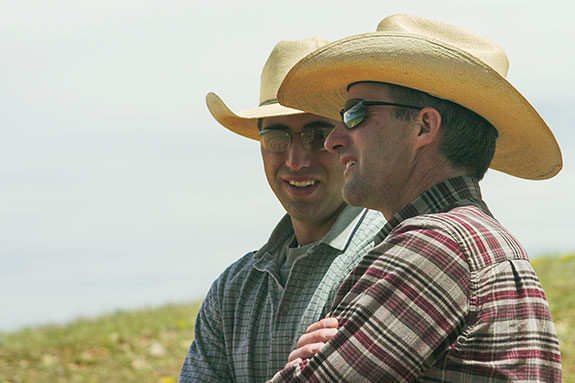Started in 1942, the Sims family has been ranching for nearly five generations near McFadden, with the ranch currently being run by Scott Sims, his son, Shanon, and their families.
Sims Cattle has always been predominately a cow-calf and hay operation. Since about 1989, the ranch has been utilizing Allan Savory's method of high density, short duration grazing.
"This (management change) has allowed us to become more sustainable by allowing us to harvest more feed with the cow and less mechanically,” says Shanon Sims. In addition, these methods have improved the land's forage production and drought resistance.
The Sims also began to swath or windrow-graze their cattle. They heard that this method of stockpiling hay in the field and grazing it through the winter months was being done by the Deseret Ranch in Utah with a lot of success and decided to give it a try.
"Through our own experience, rained-on hay that became unfit to stack, we found that cattle readily cleaned it up in the field," says Scott Sims. The ranch began windrow grazing on an adjoining ranch with about 500 acres of hay meadows.
"Much of these meadows were rough and rocky and would be hard on machinery, so we decided this would be a good fit for swath (windrow) grazing."
The Sims ranch is going on more than 20 years of windrow grazing their cattle. Their management plan is as follows:
Around July 25, the ranch starts harvesting hay for swath grazing. The hay is cut with a Rowse Double 9 mower, allowed to cure for two to three days, and then raked into windrows using a wheel rake.
Windrow locations are alternated annually so that windrows are never in the same place two years in a row. This helps avoid damage to underlying plants. Six mower swaths raked into a single row has been the magic number for their operation. This amount will vary with higher or lower forage production.
"If windrows are too small, a larger percentage of hay is exposed to the elements and loses nutrient value," says Shanon Sims. "However, too large of windrows tend to encourage fouling by the cows during grazing, resulting in excessive waste."

Grazing of windrows begins around mid-December. In certain situations, such as the recent drought, they have begun as early as Nov. 1. Wind is normally not an issue and, in the Sims’ case, actually helps to keep the windrows free of snow.
In extreme circumstances, the Sims family has seen their cattle graze through up to 2 feet of snow to get to feed.
The hay is rationed out and strip-grazed using temporary electric fence. No back fences are used, as hay meadows are dormant at this time of year. Cattle are grazed in paddocks to allow for about three days’ worth of feed for the Sims' 300-350 dry cows, split into two groups – young and old cows, and running-age cows.
For a herd of 350, three days’ worth of feed consists of about 13-15 tons of hay per paddock, and the Sims have found that paddocks providing more hay than this gives cows too much time to bed in, leading to fouled, wasted hay.
The ranch tries to have all windrows grazed by April 1, before warmer and wetter weather leads to palatability issues. The cowherd finishes out the winter on stacked hay until spring turnout in late May.
Recordings for animal days are recorded for each pasture during grazing, allowing the family to estimate production and predict how many temporary division fences will be needed. In addition, forage analysis samples are taken to determine forage quality and whether or not supplementation is necessary for cows.
"Our swath grazed hay averages 6.5 percent crude protein and 89 RFV," Shanon Sims says. "This is enough quality to meet our cows' requirements without any supplemental feed."
The Sims have estimated it costs them $40 per ton to grow, harvest and graze hay in windrows, and this method has allowed them to reduce their winter feeding costs by about $20 per ton.
"I would have to admit that the biggest challenge was the paradigm shift in believing that cows would survive and thrive without us putting out their portion every day,” Scott Sims says.
The Sims will tell you that while the cows were OK with the situation, it was hard for them, as ranchers, to get used to the concept. At the start, they swath-grazed only enough for their mature cows to graze a couple of months in early winter. Today, the entire Sims operation has transitioned over to grazing windrows for the entire winter.
In the end, the Sims say they believe their cattle are more content swath grazing because they can graze as they wish, instead of waiting on the tractor to show up with their daily portion.
"We could not believe that they could do this the whole winter," he says. "We had to figure out what else to do with our time besides feed every day." FG
PHOTOS
TOP: Shanon Sims, left, and his father Scott Sims look over their ranch in southeast Wyoming.
BOTTOM: Because of windrow gazing, the Sims' cattle are able to still graze in winter. Photos courtesy of Jesse Bussard.












